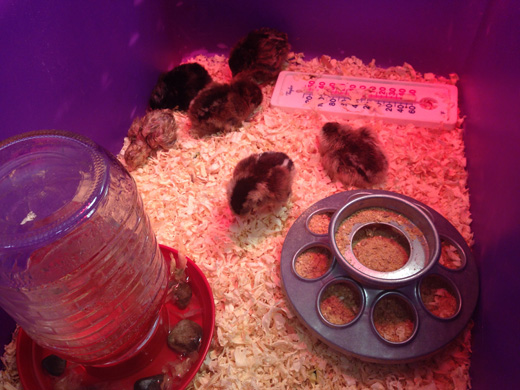hatching science center
Brooding Chicks
 A brooder, or a rearing box, is a temporary home for baby chicks up to one week of age. Newly hatched chicks must be kept warm and free from drafts, be properly fed and watered, and be protected from predators.
A brooder, or a rearing box, is a temporary home for baby chicks up to one week of age. Newly hatched chicks must be kept warm and free from drafts, be properly fed and watered, and be protected from predators.
A cardboard box approximately 2' x 2' x 1' provides a home for up to 12 chicks. The size and shape of the box is not critical, but there should be enough space for the chicks and the equipment to feed and water them. A screen or wire mesh should cover the box to restrict handling and to protect the chicks from cats and other predators.
Keep the temperature at the level of the chicks at about 90-95°F. In most rooms, a heat light bulb placed over the box will provide enough heat. A clamp-on desk lamp works well. The chick's behavior can be a guide to their comfort. When they are cold, they bunch up and give a distressed “cheep.” If they are too warm, they stand apart with their beaks open and their throats may show a panting motion.
The bottom of the brooder should contain about 2 inches of litter material to give the chicks better footing and help keep the box clean. Soft pine wood shavings, untreated cat litter, chopped straw or paper, or sand are suitable materials. Do not use newspaper. Newspaper is too slippery for the chicks to gain traction. Replace the litter when necessary to keep the box clean and dry.
Waterers made from canning jars are often available at farm supply stores. They should be placed onto a wooden block to help keep them free from litter. A small dish—with marbles or pebbles on the bottom to keep chicks from drowning—can be used for a waterer. You can also use a saucer with a heavy cup or mug placed upside down in the saucer. Add water to the saucer so the chicks can drink without getting in the water. Replace the water at least twice a day to keep it clean and fresh. Clean the waterer during each change, and refill it with lukewarm water.
Although chicks don't need food or water for the first 48 hours after hatching, both are usually provided as soon as the chicks are placed in the brooder. Use a small box or tray for the feeder. The chicks will scratch around in the feed the first few days. This will introduce them to the feed. It is best to use a chick starter mash available at most farm supply stores. This mash contains a combination of protein, fats, vitamins and minerals required for proper growth and development.
 Below is a list of brooding materials we tested. The materials were thoroughly researched and approved due to their ease of use and high customer satisfaction ratings. However, there are many, many ways to be successful in hatching chicks, and any individual who would like to try different materials is encouraged to do so.
Below is a list of brooding materials we tested. The materials were thoroughly researched and approved due to their ease of use and high customer satisfaction ratings. However, there are many, many ways to be successful in hatching chicks, and any individual who would like to try different materials is encouraged to do so.
Incubator
The Brinsea Mini II Advance is an excellent choice for 21-day eggs. It is a basic, affordable, and reliable model. This incubator can incubate up to 7 eggs at once.
Brooder Box
Almost any container that keeps chicks contained and isolates heat will work. We used a semi-transparent plastic tub that offers students a view of the chicks. This inexpensive option can also double as a storage container for project materials.
Clamp Lamp Frame
A clamp lamp frame will allow you to adjust the height of the light to maintain a temperature between 90°F-95°F. We used the Bayco Brooder Clamp Lamp.
Red Heat Lamp Bulb
Truly, any color of bulb is fine as long as the bulb produces the appropriate amount of heat (90°-95°F). Red bulbs are believed to reduce chicks pecking at each other. We selected Fluker's Red 100 Watt Heat bulbs.
Litter
We used wood shavings, which can often be sourced through forestry products stores for free or almost free, or at ranch supply stores for only a few dollars. Wood shavings are generally regarded as the best material for chick litter.
Feeders/Waterers
We used mason-jar based feeders and waterers.
Food
Chick starter feed is available in the form of mash, crumbles, and pellets and all are available in medicated and non-medicated forms from most ranch supply stores. If the chicks will be outside before they are 6 weeks, they will need medicated feed. For the first six weeks, chicks do not need grit.
